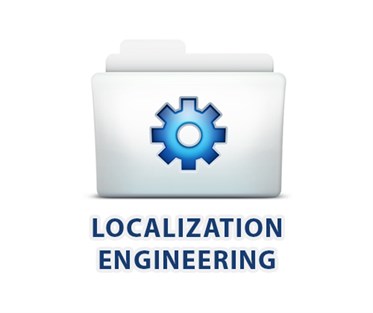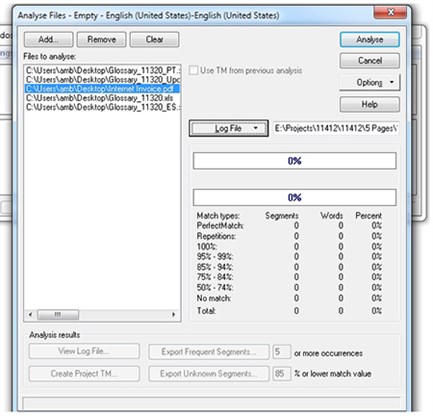Localization Engineers – what do they do?
What does a localization engineer do?
The term is used in most Translation/Localization Companies to describe a position that really encompasses a variety of roles or responsibilities. Localization engineering is one of the most critical jobs in the Localization (L10n) industry, as it is one of the first client touch points when it comes to actual media or files. If localization engineers don’t do their job well, projects will not get off on the right foot.

What might a typical localization engineer job description look like, not that there is a typical L10n engineer job description.
JOB DESCRIPTION:
1. Analysis of document, software and website localization kits including all source files for quotation
2. Analysis and preparation of document, software and website localization kits including all source files and various formats for translation project workflows
3. Research, training and reports on assigned localization tools and topics as required
3. Participate in client calls to support project managers and sales representatives
4. Maintenance of translation memories on assigned accounts
5. Participate in trainings, webinars and demos of different technologies/applications related to localization and internationalization.
6. Creation and configuration of translation tools (CAT and MT)
Teamwork is essential to the role of localization engineer as it is one of the first set of tasks in the localization process and during the engineering processes the engineer deals with many internal clients and different departments, such as project management, account management and the desktop publishing team. Localization engineers deal with many different external clients from all kinds of industries. An engineer should have the knowledge, skills and experience to deal with different types of source files starting from simple MS Word and InDesign files, to very complicated software files and multimedia audio/video format files.
Due to the nature of the job, a localization engineer needs to be always available upon request during the translation process in order to handle different requests such as translation technical questions, PM requests, client modifications, etc…
Knowledge of a variety of localization tools and techniques is essential to the job from creating simple macros in MS Office and Excel formulas in Excel documents, to skilled use of a range of localization and preparation tools such as Trados Workbench. There are much more complex tools used for website and software applications that a localization engineer must utilize as well. These tools protect and preserve coding in order to translate content without affecting the usability and features of the web or software application.
Localization Workflow
The localization engineer work flow starts when the client or a potential client submits a request with their project manager or account manager. Many times it is an initial question asking for some technical information about what it takes to localize an application or a set of files. The localization engineering team assists the client to select the best approach to localize the application/web app. In addition to the overview of the process and tools to be utilized, the client submits the actual source files (localization kit) and the engineering team reviews in detail the type of source files, and then decides the final and best solution to prepare and analyze these files.
Preliminary Engineering
Based on the type of files submitted, the preparation will be started using the necessary tools. Depending on the type of files they can be prepared in different ways, For example, MS Word documents will not always just include text but can also included images with text that needs localization, which requires extra action for preparation with help of the desktop publishing department in the company.
Other files like Excel files are a little more complicated due to the nature of the structure of the file which could include formula’s, calculations, data retrieve from other sheets or cells which need a different way of preparation. PowerPoint files are usually requested to be translated and these types of files could include MS Word or Excel components which need to be carefully prepared. There are many other source files types other than the simple ones mentioned above. Formats such as programming and markup files (C# sharp, T- SQL, PHP, Java, xml, html, etc..) require more complicated steps for preparation. In order to protect and preserve the non- translatable source code and extract the content for translation the localization engineer should have good knowledge and background about all of these programming and markup languages. Sometimes these kinds of files cannot be translated in their current format and need to be converted into a translation standard file type, such as XLIFF which stands for XML Localization Interchange File Format and is an XML-based format created to standardize the way localizable data is exchanged between tools during the translation/localization process.
Translation Memories
The translation memory is a repository that holds all of a client’s previous translations per language, from previous projects handled. It helps provide consistent quality translations based on previously saved translations, and it also reduces the price per word based on various levels of matching to previous translations.
Due to the very important role of the Translation Memory (TM’s) mentioned above, the localization engineer has a critical daily task to maintain the integrity of a client’s TM’s and keep them updated and at times should be able to fix the TM’s if they are corrupted for any reason.

Glossary Development
Localization engineers also may play a role in preparing glossaries for a client during the preliminary stage of the localization engineering process by using various translation tools that deal with terminology extraction and management. Engineers run these tools over volumes of content and can help create source glossaries for review by the linguistic teams and the client before actual translation of terminology commences.
Final engineering
Final engineering is the process of handling all translated files and prepare them for final delivery in the original format in which the client submitted them. Based on the type of files, the final engineering process can be simple or complex. Simple files such as MS Word can be prepared and reviewed quickly when needed. Other files such as software or web application files need to be reviewed in a much more detailed way, using engineering tools to be sure that all the internal code are intact and that there are no missing translations. Some files need to be sent to other departments (desktop publishing or web development) to review and ensure they are ready for a next step or final delivery.
In Summary
In order for localization engineers to provide high quality service and fulfill their role in a localization team, they must have the knowledge, the experience and the problem-solving and communication skills to do their job. Some localization issues are not only solved by pure technical knowledge but also require experience and communications skills with different localization departments. Localization engineering is very important job in the localization industry that touches almost all of the translation processes and has obvious impacts on service quality and costs. Engineers need to stay up to date with the latest translation concepts, new tools and technical information and attend courses related to this industry in order to be able to handle this job efficiently.
